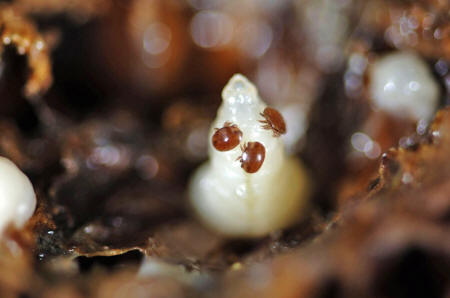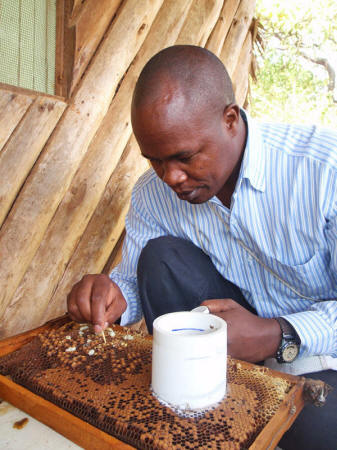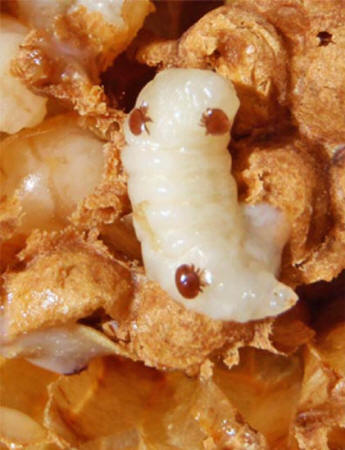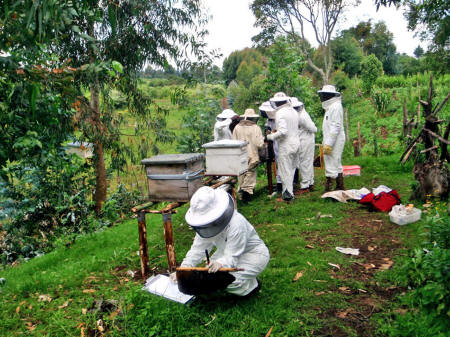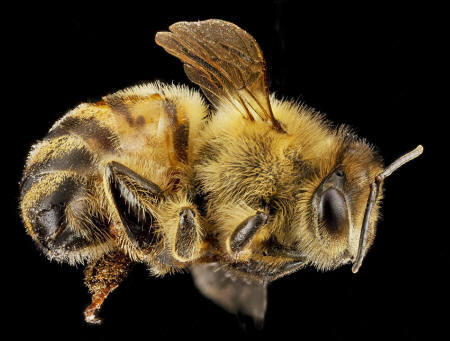|
from LiveScience Website
(the post-larval
stage of a honey bee's life cycle).
The honey bearers arrived in the early 17th century, carried into the United States by early European settlers.
Apis mellifera, a name that truly translates as "bee honey-bearer" - though they are better known as honey bees.
Over the ensuing centuries, they have flourished in the temperate North American climate - so successful, they've become an integral part of America's agricultural economy, contributing more than $14 billion in pollination services each year.
They're trucked by the thousands to our apple orchards and blueberry farms, our fields of squash and watermelon. Over the last decade, however, the honey bearers have suffered. They've died in alarming numbers, entire colonies collapsing into ruin.
The culprit seems to be a complex quartet of factors - poor nutrition, parasites, pathogens and pesticides - and scientists are still uncovering how these stresses harm bees, and how they can be prevented.
Could the answers to some of these questions lie in Apis mellifera's African ancestors?
Elliud Muli, a scientist at Kenya's International Centre of Insect Physiology and Ecology, inspects a drone brood for Varroa mites. Brood refers to the eggs, larvae and pupae of bees. Muli, a beekeeping expert, was a collaborator on recent NSF research studying the mites.
Credit: Maryann
Frazier, Pennsylvania State University
Out of Africa
In 2010, a team of researchers from Penn State and the International Centre of Insect Physiology and Ecology (ICIPE) in Kenya discovered the deadly Varroa mite was present on Kenyan bees.
A tiny red beast that attaches, shield-like, to the back of a bee, Varroa feeds on bee hemolymph (bee blood). The blood-sucking in itself is akin to a (rather large) tick bite on a human, but the process can transmit diseases and wreak havoc with a bee's immune system.
The parasite's full name - Varroa destructor - is apt; it is the culprit for many bee deaths in North America and Europe.
Varroa mites on a honey bee drone brood. Varroa is the most deadly parasite for honey bees, and has decimated their populations around the world. Credit: Maryann Frazier, Pennsylvania State University
That research was the first time Varroa was documented in East Africa.
The parasite's original host was the Asian honey bee, Apis cerana, which evolved to tolerate the mite.
When Varroa jumped to Apis mellifera - thanks to people transporting bee colonies around the world - the Western honey bee had no such built-in tolerance.
So the team applied for a grant from the National Science Foundation's (NSF) Basic Research to Enable Agricultural Development, or BREAD, program.
NOTE: BREAD supports creative, fundamental research designed to help small-holder farmers in the developing world. The program is a collaboration between NSF and the Bill & Melinda Gates Foundation.
Through BREAD funding, they analyzed the health of bee populations at 24 sites across Kenya.
The team included scientists from Penn State University, ICIPE, and South Eastern Kenyan University. They scrutinized the hives, looking for bees affected by parasites, viruses and pathogens.
The researchers found that, despite Varroa, African bees are surviving, tolerating the parasites.
The bees did not seem to be actively fighting or removing the mites; instead, they had a higher tolerance for living with them. Researchers also discovered a link between elevation and Varroa: Bee colonies at higher elevations had higher instances of Varroa. This suggests a bee's environment may make it more or less susceptible to the mites.
And since environment is also closely related to nutrition - higher elevations often have less flowering plants, which means less food options for honey bees - improving bee nutrition could be one way to combat Varroa.
The relationship between elevation (and climate), nutrition and pathogens needs to be examined further, but Christina Grozinger calls it a "very intriguing" correlation.
Increasing the diversity of flowering plant species in a landscape - one way to boost bee nutrition - could potentially help bees help themselves, by increasing a bee's natural ability to tolerate Varroa.
An NSF-supported research team collects hive samples and data on honey bee colonies in Kenya's Aberdare Mountains. The scientists analyzed bee populations at 24 sites across Kenya, looking for bees affected by parasites, viruses and pathogens. Credit: Diana Sammataro
Saving American bees
The research (Evaluation of the Distribution and Impacts of Parasites, Pathogens, and Pesticides on Honey Bee - Apis mellifera - Populations in East Africa) was published last year in PLOS One, and it represents just a "first blush" at analyzing African bee populations, said Maryann Frazier, a senior extension associate at Penn State and another scientist on the project.
A honey bee, Apis mellifera.
This bee was
collected in Beltsville, Md.
But it's important to study honey bees in other parts of the world, Frazier said, and not just because pollinators are a global resource (in Kenya, honey bees provide crucial income and nutrition for farmers and rural families).
The more we learn about the ancestral honey bee population, the more insights we glean into how we can protect and preserve U.S. honeybees, especially since multiple studies indicate African honey bees have more natural resistance to Varroa.
Much about those mechanisms remains undiscovered.
Frazier, Grozinger and their collaborators are sequencing whole genomes of individual bees collected from different parts of Kenya. This should allow the researchers to identify specific genes that have helped the bees adapt to different environments, and potentially adapt to resist different diseases.
The team is also analyzing whether different hive types - many Kenyan beekeepers use hollow logs or trees as hives, as opposed to artificially made hive boxes - affect honey bee health and productivity.
The Kenya research is but one of many bee studies supported by NSF, including research into the role of gut microbes in bee health, how bees develop colony-level social immunity, and more than 250 current pollinator-related projects.
Many of those studies are highlighted in the recent Pollinator Research Action Plan, a national strategy to better understand pollinator losses, and improve pollinator health - and ensure the honey-bearers thrive for many years to come.
|


